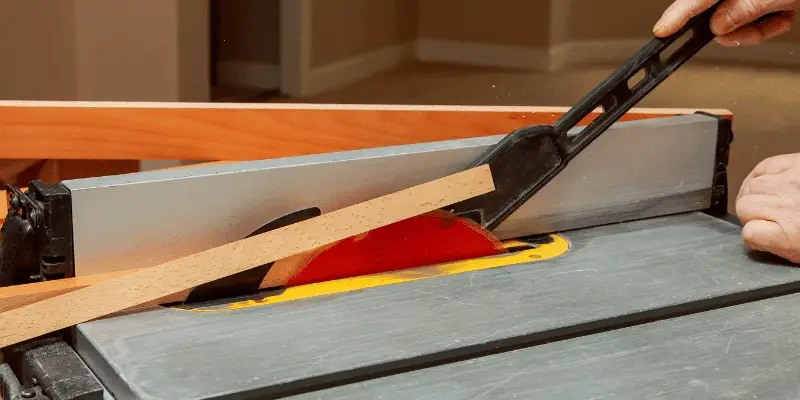To build a table saw table, assemble the frame using sturdy wood and reinforce it with braces. Then, attach a sturdy tabletop and a fence for accuracy and safety.
Building your own table saw table can be a satisfying and cost-effective way to improve your woodworking setup. With the right materials and careful planning, you can create a custom table that fits your specific needs and preferences. Whether you’re a hobbyist or a professional woodworker, having a sturdy and reliable table saw table can make a significant difference in your projects.
We’ll discuss the steps and considerations for building a table saw table that meets your requirements and enhances your woodworking experience.
Planning Your Table Saw Table
If you’re a woodworker, then you know the value of having a quality table saw table. Planning your table saw table is an essential step in creating a functional and efficient workspace. From assessing the space and workflow needs to choosing the right materials and tools, each decision you make at this stage will impact the overall functionality and productivity of your table saw table.
Assessing The Space And Workflow Needs
Before embarking on building a table saw table, it’s crucial to evaluate the available space in your workshop and determine the workflow needs. Consider the dimensions of your table saw and the surrounding space required for loading and manipulating materials. Additionally, take into account any specific workflow requirements, such as the need for storage space for accessories, jigs, and other tools.
Choosing The Right Materials And Tools
Choosing the materials and tools for your table saw table construction is a critical step. Select high-quality materials that can withstand the demands of woodworking. Look for sturdy and stable options to ensure the durability and longevity of your table. Moreover, gather the necessary tools such as a saw, drill, measuring tape, and screws to facilitate the construction process.
Understanding Table Saw Table Dimensions
Understanding the dimensions of a table saw table is crucial to ensure that it fits your specific needs. Measure your table saw and consider any specific requirements based on the size and type of projects you typically handle. Adhering to standardized table saw table dimensions will enable you to work comfortably and efficiently while ensuring safety and precision in your woodworking tasks.
Important Safety Considerations
When it comes to building a table saw table, it’s crucial to prioritize safety at every step of the process. Important Safety Considerations
Using Personal Protective Equipment (PPE)
Prioritize your safety by utilizing the necessary personal protective equipment (PPE) when working with a table saw. This includes wearing eye protection to shield your eyes from flying debris and ear protection to guard against the loud noise generated by the saw. Additionally, wearing fitted clothing and avoiding loose accessories can help prevent accidents caused by clothing getting caught in the saw’s moving parts.
Knowledge Of Table Saw Safety Features
Before operating a table saw, it’s imperative to familiarize yourself with its safety features. This includes understanding the function of the blade guard, anti-kickback pawls, and the rip fence
Workshop Safety Protocols
One of the most critical safety considerations when building a table saw table is ensuring that your workshop safety protocols are in place. This involves maintaining a clean, organized workspace, keeping the floor free of debris and tripping hazards, and ensuring that the saw is placed on a stable surface. Furthermore, having a clear understanding of emergency shut-off procedures and having a first aid kit readily available can help mitigate potential risks.

Designing The Table Saw Table Setup
In designing the table saw table setup, there are several key elements to consider to ensure a functional and ergonomic work surface. From outlining the blueprint and measurements to incorporating features for tool accessibility, every aspect plays a crucial role in creating a well-designed table saw table setup. Let’s delve into the essential factors to focus on when designing a table saw table.
Outlining The Blueprint And Measurements
Before diving into the construction process, meticulously outlining the blueprint and taking accurate measurements is paramount. This ensures precise dimensions and alignment, promoting a sturdy and reliable table saw table setup. Considerations such as the table’s size, height, and placement of the saw within the layout are crucial for a seamless workflow. Utilize this stage to plan and visualize the ideal design, taking into account the available workspace and future expansion possibilities.
Ergonomic Considerations For Comfort
Prioritizing ergonomic considerations is essential to create a comfortable and efficient workspace. Incorporating features such as adjustable height options, ensuring adequate legroom, and optimizing the table’s surface area for smooth material handling can significantly enhance the overall comfort and productivity. Ergonomics not only play a vital role in minimizing physical strain but also contribute to precision and safety while operating the table saw.
Incorporating Features For Tool Accessibility
Enabling tool accessibility and organization is a key aspect of the table saw table setup. Strategically incorporating storage compartments, designated tool holders, and integrated power outlets enhances operational efficiency and safety. Accessibility to essential tools and accessories within arm’s reach minimizes downtime and streamlines the workflow, fostering a more productive and organized work environment.
Essential Tips For Building Durability
When building a table saw table, focusing on durability is crucial to ensure longevity and stability. By choosing sturdy materials, using reinforcement techniques, and weatherproofing the table for outdoor use, you can enhance its durability significantly. Let’s delve into the essential tips for building a durable table saw table.
Selecting Sturdy Materials For Longevity
When selecting materials for your table saw table, it’s important to prioritize durability. Opt for high-quality hardwood such as oak, maple, or birch for the tabletop, as these woods are known for their strength and resilience. Additionally, using metal braces and supports can further reinforce the structure, providing added stability.
Reinforcement Techniques For Stability
Incorporating reinforcement techniques such as adding additional cross-bracing beneath the table surface and using sturdy joinery methods will significantly enhance the stability of the table saw table. Consider using dovetail or mortise and tenon joints for maximum strength and longevity.
Weatherproofing For Outdoor Use
For outdoor use, weatherproofing the table saw table is essential to protect it from the elements. Applying a durable outdoor finish or using pressure-treated lumber can prevent warping, rot, and decay, ensuring the table remains in top condition despite exposure to the elements. Additionally, utilizing stainless steel hardware can prevent corrosion and rust for long-term durability.
Assembly Instructions For Diy Enthusiasts
As a DIY enthusiast, constructing your own table saw table can be a rewarding and practical project. With the right tools and materials, you can create a custom table that suits your specific woodworking needs. This article will provide assembly instructions for building a table saw table, guiding you through the step-by-step process, attaching and aligning the table saw, and custom features and modifications.
Step-by-step Process To Construct The Base
Constructing the base of the table saw table is the foundation for stability and support. Follow these steps to build a sturdy base:
- Measure and cut the lumber to the desired dimensions for the base frame.
- Assemble the frame using screws or bolts, ensuring it is square and level.
- Attach sturdy legs to the corners of the frame for support.
- Install base levelers to accommodate uneven flooring and provide stability.
Attaching And Aligning The Table Saw
Once the base is constructed, it’s time to attach and align the table saw. The following steps will guide you through this process:
- Carefully place the table saw on the base, ensuring it is centered and level.
- Secure the table saw to the base using appropriate bolts or fasteners, following the manufacturer’s guidelines.
- Adjust the alignment of the table saw blade to ensure it is parallel to the table surface for accurate cuts.
Custom Features And Modifications
Customizing your table saw table with additional features can enhance its functionality. Consider implementing the following modifications:
- Adding storage drawers or shelves for tool organization and convenience.
- Incorporating a fence system to improve the accuracy and precision of cutting operations.
- Installing a dust collection system to maintain a clean and safe work environment.
- Integrating a mobile base for easy maneuverability within your workspace.
Guide To Finishing Touches
Welcome to the Guide to Finishing Touches section of our blog post on how to build a table saw table. Here, we’ll cover the essential steps and considerations to ensure your table saw table not only functions well but also looks great and includes useful features for your woodworking projects.
Sanding And Painting For Aesthetics
Once the basic construction of the table saw table is complete, it’s time to focus on the aesthetics. Sanding the entire table surface thoroughly ensures a smooth finish, making it more pleasant to work on. Use fine-grit sandpaper to get a polished look.
Painting the table saw table not only adds a personal touch but also protects the surface from moisture and wear. Choose a durable, high-quality paint that can withstand the demands of woodworking. Apply multiple coats for an even and long-lasting finish.
Adding Storage Solutions And Upgrades
Consider adding storage solutions to your table saw table, such as drawers or shelves, to keep your tools and accessories organized and within arm’s reach. You can also include upgrades such as a miter gauge extension or a built-in router table to enhance the functionality of your table saw table.
Final Inspection And Maintenance Tips
Conduct a final inspection to ensure that all components are secure, level, and functioning as intended. Check for any rough edges or splinters that may need further sanding and addressing. Ensure that the table saw is properly aligned and calibrated for accurate cuts.
- Regularly clean the table saw table to remove sawdust and debris that can affect its performance.
- Apply a protective coating, such as wax, to the tabletop to reduce friction and prolong the lifespan of the surface.
Frequently Asked Questions Of How To Build A Table Saw Table
What Are The Essential Tools Needed For Building A Table Saw Table?
To build a table saw table, you will need a table saw, plywood, screws, drill, measuring tape, and safety gear.
How Can I Ensure The Stability And Sturdiness Of The Table Saw Table?
To ensure stability, use solid and well-constructed materials for the table legs and braces, and ensure precise measurements and secure assembly.
What Safety Measures Should I Consider When Building A Table Saw Table?
When building a table saw table, always wear appropriate safety gear such as goggles and gloves, handle tools carefully, and follow all safety guidelines recommended by the table saw manufacturer.
Conclusion
Building a table saw table can be a fulfilling and practical project for any DIY enthusiast. With the right tools, materials, and a clear plan, you can create a sturdy and versatile table to enhance your woodworking experience. Whether for personal use or professional projects, a custom table saw table can optimize your workspace and improve efficiency.



6 thoughts on “How to Build a Table Saw Table: Essential Tips for DIY Enthusiasts”